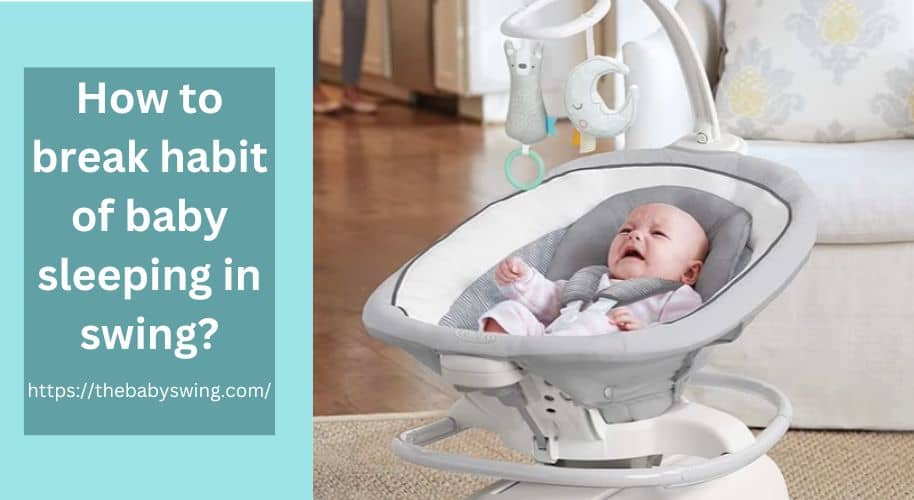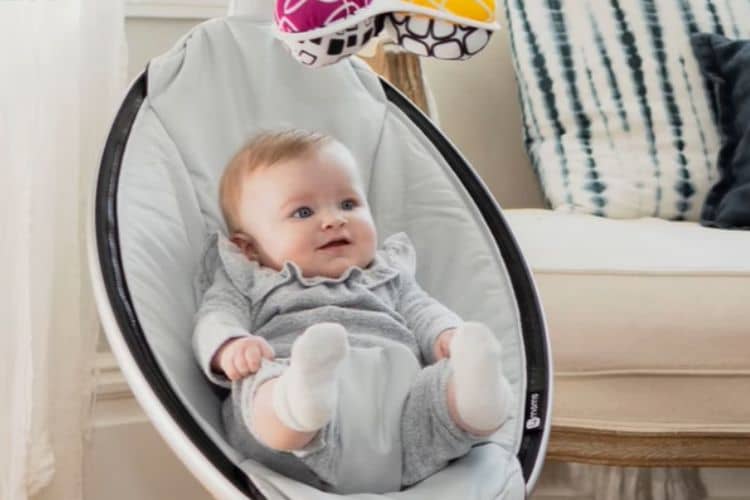Last Updated on July 19, 2023
If you’re like many parents, you may have gotten into the habit of putting your baby to sleep in a swing. It’s easy and convenient, but it’s not the best option for your baby’s safety or development.
In this article, we’ll discuss how to break the habit of a baby sleeping in a swing. We’ll also talk about the best practices for safe sleep, so your little one can get the rest they need. So, keep reading!

How to break habit of baby sleeping in swing?
Breaking the habit of a baby sleeping in a swing can be challenging, but it is possible with some dedication and patience. You need to understand that babies are used to being rocked or soothed in this way, and it can take time for them to adjust to other forms of sleep.
By following these steps, you can help ensure your little one gets the rest they need without relying on the swing.
1. Avoid the Swing When Putting Your Baby to Sleep:
The first and most crucial step in breaking your baby’s swing habit is to avoid using the swing when putting them down for naps and bedtime. Instead, put your baby directly in a crib or bassinet — it’s safer and allows your little one to learn how to self-soothe themselves to sleep.
2. Create a Comfortable Sleeping Environment:
If you want your baby to stop sleeping in the swing, create an optimal environment for them outside the swing. Make sure their crib or bassinet is comfortable and safe, with no loose sheets or blankets that could hinder their breathing or development.
You can also use white noise machines, nightlights, and other sleep-promoting objects to help your baby feel more relaxed.
3. Establish a Bedtime Routine:
A consistent bedtime routine helps create healthy sleep habits and can make it easier for your baby to transition from the swing to the crib.
It is key to make it soothing and enjoyable — dim the lights, read stories, use calming music, give them a massage or warm bath, etc. Anything that helps relax them before bedtime will make this transition smoother for both of you!
4. Be Patient:
Changing habits takes time, so be patient with yourself and your little one as you slowly break their sleeping in the swing habit. Remember that it won’t happen overnight; instead, take small steps every day until you reach your goal.
5. Ask for Help:
If you’re feeling overwhelmed or frustrated during this process, don’t hesitate to ask for help from a certified pediatric sleep consultant or family therapist. They’ll be able to provide personalized advice and support that could help make the transition much smoother.
The most important thing is that you take care of yourself so you can take care of your baby.
By following these tips, you can break the habit of a baby sleeping in a swing and create healthier sleep habits for your little one. It may take some time and effort, but it’s worth it for their safety and development!
Also read: Letting baby sleep in swing when congested
When should a baby stop sleeping in a swing?

According to the American Academy of Pediatrics, babies should not sleep in a swing for prolonged periods of time. Babies under four months of age should be moved to a crib or bassinet once they’ve fallen asleep in the swing.
For babies over four months old, experts recommend limiting their time in a motorized swing to an hour or less a day.
Additionally, infants should be seated in the most reclined position offered by the swing to decrease the chance of them slumping forward and suffocating.
“Parents should ensure their baby is safe and comfortable in the swing and they should regularly check the baby,” Mattie Johnson, ND, MPH, a pediatrician at Lake Stevens Natural Medicine.
“Parents avoid letting their baby sleep in a swing and make sure the swing is kept away from cords and other items that could pose a dangerous risk to the baby,” she added.
Overall, it is important to keep safety at the forefront when it comes to your baby’s sleep environment. Swings are not designed for overnight sleep and can pose serious risks if used improperly.
How do I transition my baby from swing to crib for naps?
Transitioning your baby from a swing to a crib for naps can be done with some patience and persistence. Here are the steps you should take:
- Place a pillow under the sheet in the crib so that your baby still feels the tilt they were used to in the swing.
- Reduce the amount of time spent in the swing each day, while making sure it is placed in the same room as the crib so your baby grows accustomed to their new sleeping environment.
- When you notice your baby getting drowsy in the swing, slowly and softly lift them out and move them to a firm, flat surfaces like a crib or bassinet.
- If you’re using a swing or bouncer that moves, turn it off, so they are laying still after about a week of these naps.
- As you ever-so-gently lay them in their crib, keep one hand on their back and another on their tummy to keep contact with them until they fall asleep.
- End your routine by holding them without walking around until they fall asleep before placing them down in the crib, drowsy but awake and patting them until they drift off into dreamland.
Also read: When should a baby stop using swing
What if my baby will only sleep in a swing?
If you find that your baby will only sleep in a swing, you should be aware of the risks and take steps to ensure their safety. The American Academy of Pediatrics (AAP) is against using a swing as a regular sleep environment for babies, as it can increase the risk of Sudden Infant Death Syndrome (SIDS).
Dr. Mattie says even if your baby seems to sleep better in the swing, it is essential to transition them out of it as soon as possible.
“If your baby has become accustomed to sleeping in the swing, they may need extra time and patience during the transition,” Dr. Mattie advises.
She recommends using the steps above to transition your baby gradually from their swing to the crib.
You should also practice safe sleep habits while they are in the swing. Be sure to always use the most reclined position offered and check on them often during sleep. Additionally, use a flat sheet or swaddle to make sure they are not too warm.
Can you overuse a baby swing?
While baby swings can be a great way to soothe and entertain your little one, they should not be used as a substitute for regular interaction or sleep.
Overusing a baby swing can cause your baby to become overly dependent on the motion, which can lead to difficulty sleeping and other issues.
On top of this, it can delay other developmental milestones, such as the ability to sit independently, crawl, and walk. Babies should not be in their swings for more than 30 minutes at a time, and the American Academy of Pediatrics recommends only 1 hour or less of daily use.
Wrapping Up
Thanks for reading this guide on how to break the habit of a baby sleeping in a swing. Remember that it takes patience, consistency, and persistence — but with these tips and some help from certified professionals, you can make the transition much smoother for everyone involved.
Please share this article with anyone who needs help transitioning their baby from sleeping in a swing!
Sources:
- https://www.healthline.com/health/baby/sleeping-in-baby-swing
- https://www.babysleep.com/sleep-advice/how-do-i-transition-from-a-swing-to-a-crib/
- https://www.youtube.com/watch?v=PDkTiTTCkjQ
- https://www.babycenter.com/baby/crying-colic/how-long-can-i-leave-my-baby-in-a-swing_10351368
Sharing Is Caring!

Amy A. Vincent is a Certified Pediatric Sleep Consultant and a mother of three beautiful children. She helps parents transition their babies from swing sleep to safe, independent sleep. She is passionate about helping parents teach their children the skills needed to become good sleepers and aims to make the process as easy and stress-free as possible. Read more
